Abstract
The present study aims to examine the effect of modifiers (Styrene-Butadiene-Styrene and crumb rubber) on the rutting, moisture-induced damage, and workability properties of hot mix asphalt (HMA) mixtures. In this study, three types—namely, control (CB), crumb rubber-modified (CRMB), and polymer-modified (PMB)—of mixtures/binders were evaluated. The rutting properties were evaluated using a wheel tracking device and the Multiple Stress Creep Recovery (MSCR) test. The moisture-induced damage properties were evaluated using the Indirect Tensile Strength (modified Lottman) and bitumen bond strength (BBS) tests. The workability properties were evaluated using densification indices (Bahia and locking point method) and a viscosity test. The results indicate that CRMB mixtures were less workable and exhibited a better resistance to rutting than the PMB and CB mixtures. Further, the PMB mixtures had increased resistance to moisture-induced damage, while the effect of the CRMB mixtures was negligible compared to the CB mixtures.
1. Introduction
The use of modifiers such as polymers and recycled crumb rubber has been gaining popularity in recent decades. It has been successfully adopted by transportation agencies in hot mix asphalt (HMA) pavements due to the environmental benefits and ability to improve the performance of asphalt mixtures related to rutting and moisture-induced damage [1,2,3]. Rutting or permanent deformation is one of the main causes of distress in HMA pavements and is due to the rise in traffic volume and heavier loads [4,5,6]. It is defined as the accumulation of unrecoverable strain due to applied wheel loads, resulting in a reduction in the performance and service life of HMA pavements [7,8]. Due to rutting, many problems arise, such as water accumulation, which results in the entry of water into the pavement layers and weakening of the structure [9]. In addition, water accumulation results in hydroplaning, which is a safety hazard for vehicles [10]. However, to tackle this rutting problem in the pavement, several studies have been conducted, resulting in the development of rutting models and concepts and the invention of testing methods. Most studies have evaluated the rutting properties of HMA pavements using wheel tracking test devices [4,5,6,11,12,13]. Previous studies conducted on HMA mixtures with the use of polymers and recycled crumb rubber have exhibited a better resistance to rutting [1,2,11,14,15,16]. In addition, studies carried out to evaluate the rutting resistance of unmodified and polymer-modified mixtures have shown that polymer-modified mixtures exhibit a better resistance [13,16]. Studies on crumb rubber-modified mixtures have shown better rutting resistance [15]. It is important to note that the majority of the reported work on the rutting of asphalt binder has utilized the Superpave rutting parameter (G*/sinδ), which is unsuitable for characterizing modified asphalt binder due to the unaccountability of the delayed recovery response associated with modifiers [17,18]. The refinement of the testing protocol over the years included the development of the Multiple Stress Creep Recovery (MSCR) test, which predict the high-temperature performance of modified asphalt binder better [19,20]. Results have shown that the MSCR test provides a much better correlation with mixture rutting than the existing Superpave binder criteria [19]. Therefore, considering the limitations of G*/sinδ, one of the aims of this research work was to investigate the effect of modifiers on the rutting properties of asphalt binders using the MSCR test.
Likewise, moisture-induced damage is also one of the concerns in HMA pavements and is defined as the breakdown of the adhesive bond between aggregate and asphalt due to the presence of water, which, in turn, results in a loss of cohesion, strength, and stiffness [13,21,22]. Different indirect approaches, such as the Tensile Strength Ratio (TSR) test, the boiling test, the stripping test, etc., have been used in the past to evaluate moisture-induced damage properties [13,21]. Previous studies conducted on HMA mixtures have a exhibited better resistance to moisture-induced damage with the use of polymers and recycled crumb rubber [11,14,15,16]. In addition, studies carried out to evaluate the moisture-induced damage resistance of unmodified and polymer-modified mixtures have shown that polymer-modified mixtures exhibit a better resistance to moisture-induced damage [11,16]. Studies on crumb rubber-modified mixtures have shown a detrimental effect on moisture-induced damage properties due to the higher air void content [15], which enables the loss of moisture at the asphalt–aggregate interface, causing more moisture damage [23]. However, every approach fails to answer whether failure has taken place at the aggregate–asphalt binder interface or within the asphalt binder matrix phase itself. Such information is essential so that further action can be taken to address it appropriately. Recent development in this area shows that the bitumen bond strength (BBS) using the “Pneumatic Adhesion Tensile Testing Instrument (PATTI)” test could appropriately answer this question [21].
The evaluation of workability in HMA pavements along with the mix design and mechanical properties is necessary. In recent years, workability in terms of the Compaction Densification Index (CDI) and Traffic Densification Index (TDI) has been immensely investigated by Bahia and the locking point method using Superpave Gyratory Compactor (SGC) densification curves [24,25]. CDI and TDI are densification indices used to relate the workability and rutting performance of HMA mixtures, respectively [12,13,24,25,26]. Studies on the workability properties of HMA mixtures have suggested that aggregate gradation and type have a significant effect [26]. However, the effect of modifiers on the workability properties of HMA mixtures has not been addressed. Further, rotational viscosity has been adopted successfully and considered as one of the important parameters in characterizing the workability of asphalt binders [26], due to the fact that it represents the binder’s ability to be pumped through a HMA plant and the degree of coating of aggregates in HMA mixtures [26].
2. Research Objectives and Methodology
The main research objective of the present study was to evaluate and understand the effects of varying modifiers on the mechanical properties (including rutting, moisture-induced damage, and workability properties) from the perspectives of both binders and mixtures. Meanwhile, the mix design properties were evaluated using the Superpave method for various design gyrations. Binder tests were performed using Dynamic Shear Rheometer (DSR, PRO+, Malvern Panalytical, Malvern, UK) and PATTI (Defelsko PosiTest Atlanta, USA), while the asphalt mixtures were conducted with respect to the gyration compaction test, the wheel tracking test, and the modified Lottman test in order to evaluate the desired properties.
Figure 1 presents the methodology used in the present study. The base bitumen was used as the control binder (CB), and at the same time it was mixed with CR and SBS to produce CRMB and PMB. The binder testing was conducted by considering the three target properties (workability, rutting properties, and moisture-induced damage) by means of measuring the viscosity, MSCR, and BBS, respectively. On the other hand, the three types of binders were used to prepare asphalt mixtures with varying contents (5.5%, 6%, and 6.5%) to evaluate the mix design properties and determine the optimum binder content for each mixture. Subsequently, the same three target properties of the mixtures were evaluated using the Bahia method, the locking point method, the wheel tracking test, and the modified Lottman test, respectively.
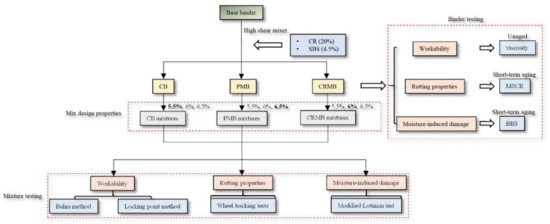
Figure 1.
Methodology used in the present study.
3. Materials, Sample Preparation, and Experimental Methods
3.1. Materials and Sample Preparation
In the present study, granite stones were used as coarse and fine aggregates, and their properties are presented in Table 1.

Table 1.
Properties of the aggregates.
The aggregate gradation of the nominal maximum aggregate size (19.0 mm) conforming to the requirements of American Society of Testing Materials (ASTM) D3515 was adopted as presented in Table 2.

Table 2.
Selected aggregate gradations.
SK-70 asphalt (South Korea asphalt with a penetration of 70, 1/10mm) supplied by a local manufacturer was used in this study for modification with Styrene-Butadiene-Styrene (SBS) and crumb rubber (CR). The CR used in the present study is from the mechanical grinding of scrap tires at room temperature; these scrap tires are comprised of 100% of the weight of car tires. The particles passed 0.600 mm and retained at 0.300 mm sieves. The contents of SBS and CR were 4.5% and 20% by asphalt weight, respectively, and were selected based on previous research articles [8,18]. Firstly, SBS and CR were added slowly to the heated base binder in approximately 2 min. Mixing was further carried out for 30 min at a rotational speed of 700 rpm under controlled temperature conditions at 170–180 °C [8,18]. The asphalt binder combinations prepared with CR and SBS were referred to as CRMB and PMB, respectively, and the properties of the CB, CRMB, and PMB binders are presented in Table 3. In order to carry out the MSCR and BBS tests, binders were subjected to short-term aging (Rolling Thin-Film Oven Test, RTFOT) as per ASTM D2872.

Table 3.
Properties of the asphalt binders.
3.2. Experimental Methods
The experimental design included the evaluation of the asphalt binder and mixture properties, as summarized in Table 4. Asphalt binder properties such as MSCR and BBS and the viscosity test of the CB, CRMB, and PMB binders were evaluated. A rotational viscosity test was carried out to characterize the workability of the asphalt binders as per ASTM D4402 using a Brookfield viscometer. The viscosity values of unaged CB, CRMB, and PMB binders were measured in the temperature range from 120 to 180 °C at intervals of 15 °C.

Table 4.
Experimental design of the various performance parameters.
The MSCR test was conducted on short-term aged CB, CRMB, and PMB binders using DSR with a parallel plates (oscillating plate and fixed plate) arrangement at 64 °C as per American Association of State Highway and Transportation Officials (AASHTO) TP70, as shown in Figure 2.
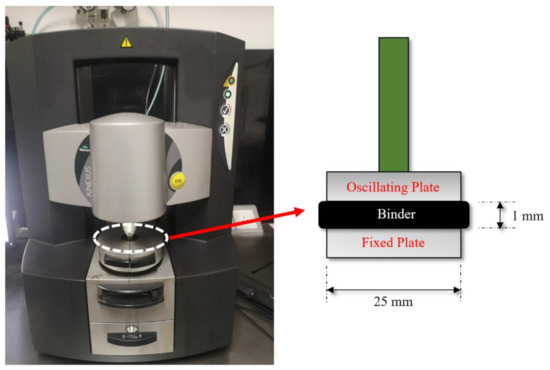
Figure 2.
DSR used in the present study.
The samples were subjected to 10 loading cycles; each consists of 1 s as a creep period and 9 s as a recovery period at standard stress levels of 0.1 and 3.2 kPa. The strain response was recorded over the entire loading and recovery periods. Based on the recorded strain response, the recovery (%R) and non-recoverable creep compliance (Jnr) values were calculated as per Equation (1) and Equation (2), respectively. Further, the Jnr measured at 3.2 kPa was utilized to check the suitability of different asphalt binder combinations for different traffic levels, as per AASHTO MP 19. Moreover, the difference in the Jnr value (Jnr_diff) corresponding to the stress levels of 0.1 and 3.2 kPa was also analyzed to investigate the influence of modifiers on the stress sensitivity aspect (Equation (3)).
where R (%) = percentage recovery, ε10 = strain at the end of each recovery period, ε1 = strain at the end of each creep loading period, Jnr = non-recoverable creep compliance (kPa-1), and τ = standard stress level during the creep loading phase. Jnr_0.1 and Jnr_3.2 are the non-recoverable creep compliance values for the creep loadings of 0.1 and 3.2 kPa respectively.
The BBS test was conducted on short-term aged CB, CRMB, and PMB binders as per AASHTO T 361, as shown in Figure 3.

Figure 3.
Bitumen bond strength (BBS) test setup.
The granite aggregate samples were cut into approximately rectangular shapes (100 mm × 100 mm) to accommodate the testing of at least three replicate samples. The pull-off stubs were initially heated at 150 °C for 30 min to remove the moisture, if any. Aggregate substrates were also kept at 60 °C for preparing specimens for BBS testing. Preheated asphalt binder was initially poured into a silicon mold (to accommodate the control volume required for sample preparation). Aggregate substrates and pull-off stubs were further taken out from the oven, and asphalt binder from the silicon mold was instantly transferred to the pull-off stub and kept undisturbed for 10 s. The asphalt poured pull-off stub was further pressed firmly on the aggregate surface until an excessive amount oozed from the bottom of the stub. For dry conditioning, the samples were left at room temperature for 24 h. For wet conditioning, the samples were first kept at room temperature for 1 h, followed by submergence in the water bath at 40 °C for 24 h.
Testing was performed using PATTI at a calibrated axial tensile loading rate of 0.69 MPa/sec. The Pull-Off Tensile Strength (POTS) value was calculated using Equation (4), and the Bond Strength Ratio (BSR) was evaluated as per Equation (5).
where Ag = contact area of gasket with reaction plate (mm2); BP = burst pressure (kPa); APS = area of pull stub (mm2); C = piston constant. The POTSs for the conditioned and unconditioned samples are referred as POTSwet and POTSdry, respectively.
In order to evaluate the asphalt mixture properties, three types of mixtures (CB, CRMB, and PMB) was evaluated. The Superpave mix design procedure was adopted as per Superpave series No. 2 (SP-02), and subsequently the mixing and compaction temperatures adopted were 150–165 °C and 135 °C, respectively (SP-02). The design gyration (Ndes) of 75 gyrations was adopted to compact Superpave specimens with 100 mm diameters based on the nominal maximum aggregate size requirements, as recommended in SP-02. The mix design properties of the CB, CRMB, and PMB mixtures were conducted at three binder contents (5.5%, 6.0%, and 6.5%), and the design asphalt content (ACdesign) of each mixture was optimized based on the requirements of SP-02. To evaluate the workability properties, loose asphalt mixtures were compacted to 98% Gmm or 225 gyrations using SGC [24,25]. The number of gyrations, CDI, and TDI were calculated by adopting the Bahia and locking point method [11,12,13]. To evaluate the rutting properties, asphalt slab specimens of dimensions 300 × 300 × 50 mm were fabricated with a Voids in Total Mixtures (VTM) of 7.0 ± 0.1% at their respective design asphalt contents. A small-size wheel tracking test device was used to evaluate the rutting properties (rut depth at 10,000 passes and dynamic stability) as per EN 12697-22 in dry conditions at a testing temperature of 60 °C. To evaluate the moisture-induced damage properties, mixtures were prepared at design asphalt contents and were compacted into cylindrical specimens (VTM of 7.0 ± 0.1%). The moisture-induced damage properties, such as the indirect tensile strength (ITS) and tensile strength ratio (TSR), were evaluated according to AASHTO-T283 (modified Lottman test).
4. Results and Discussion
4.1. Mix Design Properties
Table 5 represents the mix design properties of the CB, CRMB, and PMB mixtures.

Table 5.
Results of the mix design properties.
The bulk density (Gmb) values of the CB, CRMB, and PMB mixtures were found to be 2550, 2380, and 2410 kg/m3, respectively. The results clearly indicate that a lower density was observed for the CRMB and PMB mixtures compared to the CB mixtures. For instance, a reduction in density of 6.7% and 5.5% was noticed with the CRMB and PMB mixtures with respect to the CB mixture. According to the specifications of SP-02 (Asphalt Institute, 2001), at 4 ± 0.1% VTM, the optimum asphalt contents (OACs) of the CB, CRMB, and PMB mixtures were found to be 5.5%, 6.5%, and 6.0%, respectively, indicating that the addition of modifiers requires a higher asphalt content to achieve the target VTM. Similar findings were noticed by Lee et al. [14] and Saboo and Kumar [15], with the use of polymers and recycled crumb rubber in HMA mixtures, indicating that the OAC for the asphalt mixtures with polymers and recycled crumb rubber is approximately 0.5–1% higher than for the control mixtures. The specifications of SP-02 (Asphalt Institute, 2001) suggest that the Voids in Mineral Aggregate (VMA) values should be a minimum of 13% and the Voids Filled with Asphalt (VFA) values should be in the range of 65–78%. The results clearly indicate that the CB, CRMB, and PMB mixtures had VMA values greater than 13%, and the VFA values were within the limits. Further, it can be noticed that the addition of modifiers resulted in higher VMA and VFA values.
4.2. Workability Properties
The viscosity values of the CB, CRMB, and PMB binders are shown in Figure 4. The results clearly indicate a decrease in the viscosity values with an increase in temperature, irrespective of binders. In addition, at a particular temperature the CRMB and PMB binder exhibited a higher viscosity compared to that of the CB binders. The possible reason for this may be that the addition of the CR and SBS modifiers could stiffen the bitumen, resulting in a higher viscosity value. Based on the viscosity results, it can be concluded that the addition of modifiers reduces the pumping ability in the HMA plant. Further, it can be concluded that the CRMB binder exhibited a higher viscosity compared to the PMB binders. This may be explained by the fact that the CR particles absorbed a large amount of light oil in the base binder during swelling, which caused the viscosity of the base asphalt to increase. As the temperature increases, the viscosity of PMB approaches that of CB, while the value of CRMB is still higher than that of CB. It can be inferred that PMB can have a similar workability to CB at a proper mixing temperature, while even at a higher mixing temperature of 180 °C the workability of CRMB is still weaker than that of CB. In addition, the viscosity of CRMB is more sensitive to temperature than that of PMB, followed by CB. Therefore, the mixing temperature should be optimized as different types of modifiers are used.
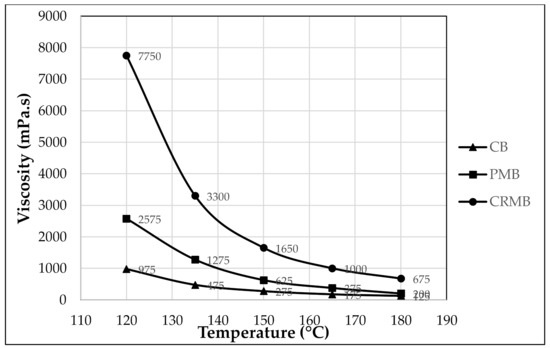
Figure 4.
Viscosity test results.
Figure 5 represents number of gyrations and the CDI and TDI values calculated using the Bahia and locking point methods for the CB, CRMB, and PMB mixtures.
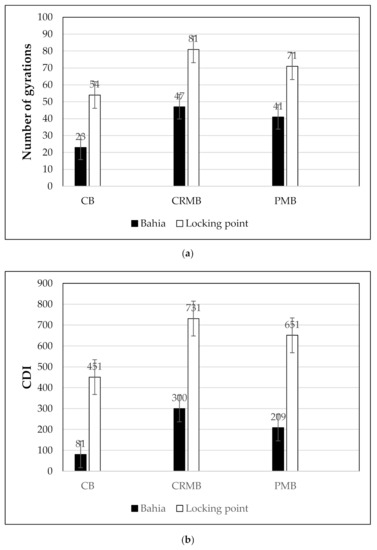
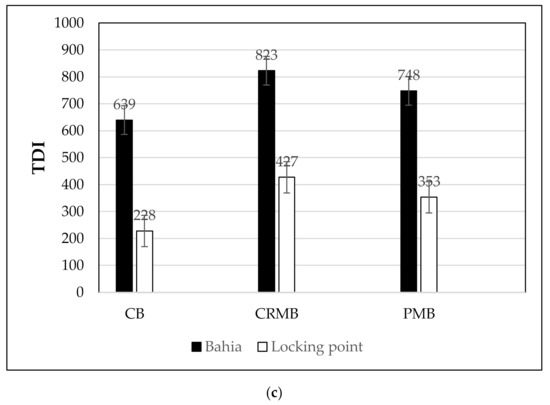
Figure 5.
Workability test results: (a) number of gyrations, (b) Compaction Densification Index (CDI) and (c) Traffic Densification Index (TDI) values.
The results clearly indicate that the number of gyrations and the CDI values for the CRMB and PMB mixtures were higher than those of the CB mixtures for both the Bahia and socking point methods. For instance, increases in the CDI values by 62.2% and 43.9% were observed for the CRMB and PMB mixtures compared to the CB mixtures when calculated using the locking point method. As a result, it can be concluded that the CRMB and PMB mixtures take more energy for densification and were less workable compared to the CB mixture, due to fact that the CRMB and PMB mixtures exhibited a lower density. Similarly, the TDI values of the CRMB and PMB mixtures were higher than those of the CB mixture for both the Bahia and locking point methods. For instance, increases in the TDI values by 86.2% and 51.9% were observed for the CRMB and PMB mixtures compared to the CB mixture when calculated using the locking point method. Finally, it can be concluded that CRMB exhibited better a rutting resistance (TDI values) and was less workable compared to the PMB mixture. This was consistent with the evaluation results of workability from the perspective of the binder.
4.3. Rutting Properties
Table 6 represents the %R, Jnr, and Jnr_diff values of the CB, CRMB, and PMB binders, corresponding to 0.1 and 3.2 kPa stress levels.

Table 6.
Results of the Multiple Stress Creep Recovery (MSCR) test.
Higher %R and lower Jnr values are desirable for the improved rutting performance of asphalt binder. As expected, higher %R and lower Jnr values were noticed with the CRMB and PMB binders than with the CB binders, irrespective of the stress levels. For instance, decreases in Jnr values by 2488.2% and 197.3% were observed for the CRMB and PMB binders compared to for the CB binder at a 3.2 kPa stress level. Thus, it can be concluded that the CRMB and PMB binders exhibited a higher resistance to rutting compared to the CB binder based on the %R and Jnr values. Further, based upon the Jnr value corresponding to the standard stress level of 3.2 kPa, a binder can be categorized for different classes of vehicular loadings, as per AASHTO MP19. Table 6 clearly indicates that the addition of modifiers resulted in changing the vehicular loading grading to higher traffic loading conditions. Additionally, the stress sensitivity is considered as one of the most important parameters and it is desirable to have lower degree of stress sensitivity in an asphalt binder, which in turn helps in extending the service life of the pavement. From the results, it is evident that the addition of modifiers resulted in an increase in the sensitivity of the control binder towards the varied axle loading pattern, but this was within the requirements of AASHTO TP70 (Jnr_diff ≤ 75%).
Figure 6 represents the rutting properties in terms of the rut depth and dynamic stability of the CB, CRMB, and PMB mixtures.
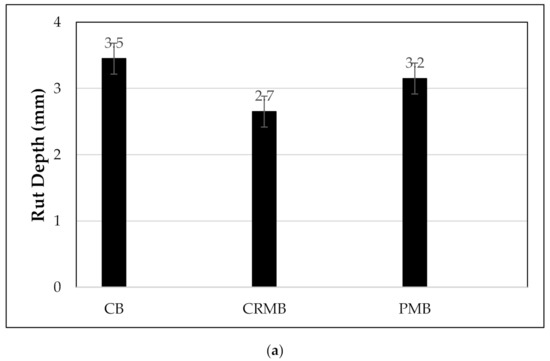
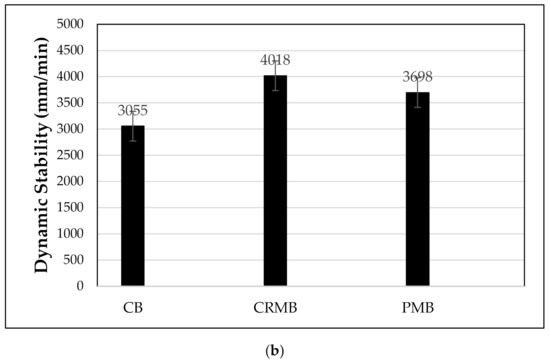
Figure 6.
Rut test results: (a) rut depth and (b) dynamic stability.
The rut depths of the CB, CRMB, and PMB mixtures were 3.5, 2.7, and 3.1 mm, respectively. Similarly, the dynamic stabilities of the CB, CRMB, and PMB mixtures were 3049, 4015, and 3695 mm/min, respectively. The results indicate that the CRMB and PMB mixtures showed a lower rut depth and higher dynamic stability values than the CB mixture. For instance, increases in the dynamic stability values by 24.1% and 17.5% were observed for the CRMB and PMB mixtures compared to the CB mixture. Thus, it can be concluded that the CRMB and PMB mixtures were more rut-resistant compared to the CB mixture, due to fact that the CRMB and PMB mixtures exhibited higher VMA values and the addition of modifiers resulted in a stiffer mixture. Finally, it can be concluded that the CRMB mixture exhibited a better rutting resistance compared to the PMB mixture. This may be due to the higher viscosity of CRMB, which is advantageous for resistance to rutting [14,15]. The rutting results were also analysed using the correlation between wheel tracking and the MSCR test, as shown in Figure 7. It is clearly evident that lower Jnr values indicated lower rut passes and a higher dynamic stability. Similarly, higher %R values indicate lower rut passes and a higher dynamic stability. The dynamic stability had a good correlation, with an R2 of 0.991 and 0.959 with respect to the Jnr and %R values, respectively. Similarly, the rut depth had a reasonable correlation, with an R2 of 0.811 and 0.728 with respect to the Jnr and %R values, respectively. In addition, it can be inferred that, for the same aggregate gradation, the increase in the rutting resistance of the mixture is basically contributed by the asphalt binder. This also shows that the increase in asphalt viscosity improves the high-temperature performance of the mixture.
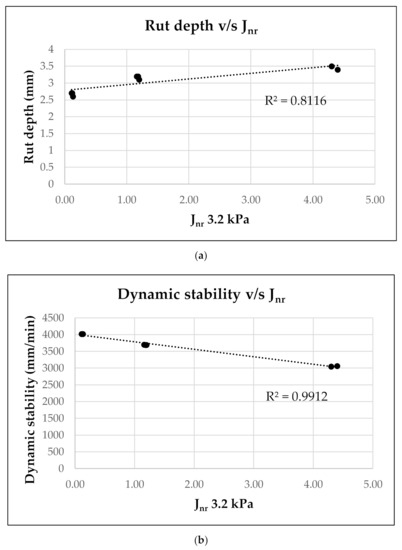
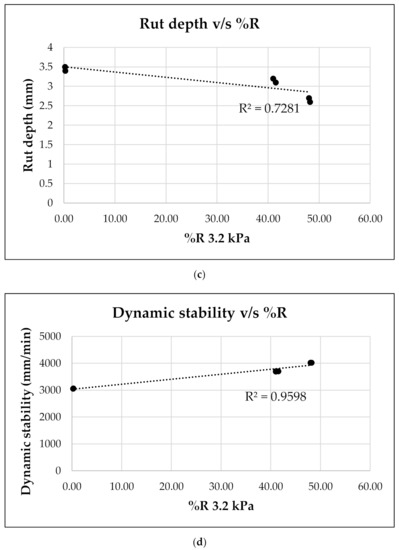
Figure 7.
Correlation between wheel tracking and the Multiple Stress Creep Recovery (MSCR) test: (a) Rut depth v/s Jnr; (b) Dynamic stability v/s Jnr; (c) Rut depth v/s %R; (d) Dynamic stability v/s %R.
4.4. Moisture-Induced Damage Properties
The bond strength properties of the CB, CRMB, and PMB binders were evaluated using the BBS test based on the POTS and BSR values. Table 7 shows the variation in POTSdry as well as POTSwet with the considered granite aggregate type of the CB, CRMB, and PMB binders. It is clear from the result that the addition of modifiers resulted in an increase in bond strength for both dry and wet conditions. For instance, increases in the POTSwet values by 10.5% and 23.3% were observed for the CRMB and PMB binders compared to the CB binder. It is important to note that the interaction between the modifiers and asphalt binders plays an important role and may affect the overall bond strength with the aggregate, as evident from the plot. The BSR values of the CB, CRMB, and PMB binders were 0.90, 0.92, and 0.94, respectively. A higher value of BSR is desirable, as it represents a relatively lower degree of decrease in POTSwet due to damage induced by the presence of moisture. It is clear from the results that the addition of modifiers resulted in an increase in the BSR values. For instance, increases in the BSR values by 2.6% and 4.7% were observed for the CRMB and PMB binders compared to the CB binder. Finally, it can be concluded that the CRMB and PMB binders had a negligible effect on the moisture-induced damage properties. This is attributable to the higher binder content, which increases the film thickness, making the mixture water-resistant [14,15].

Table 7.
Results of the BBS and Indirect tensile strength (ITS) tests.
Moisture-induced damage properties such as the ITS and TSR values of the CB, CRMB, and PMB mixtures are presented in Table 7. The results of the ITS test clearly indicate that the CRMB and PMB mixtures showed higher ITS values compared to that of the CB mixture for both dry and wet conditions. For instance, increases in the wet ITS values by 5.1% and 15.2% were observed for the CRMB and PMB mixtures compared to the CB mixture. It is to be noted that some of the Departments of Transportation in the USA have specified a minimum ITS value (Illinois center for transportation recommends the minimum ITS value as 414 kPa). However, the wet ITS values of the CB, CRMB, and PMB mixtures fulfilled the minimum requirement criteria. In addition, the TSR values of the CB, CRMB, and PMB mixtures were 87.9%, 90.1%, and 93.5%, respectively. The results of the TSR values indicate that the CB, CRMB, and PMB mixtures fulfilled the minimum TSR (85%) requirement, as suggested in SP-02 [26]. Finally, it can be concluded that the PMB mixture had increased resistance to moisture-induced damage, while the effect of the CRMB mixture was negligible compared to that of the CB mixture.
The moisture-induced damage properties were also analyzed using the correlation between the ITS and BBS test, as shown in Figure 8. It is clearly evident that higher TSR and BSR values indicated a better resistance to moisture-induced damage. The ITS and TSR values had a good correlation, with an R2 of 0.972 and 0.893 with respect to the POTS and BSR values, respectively.
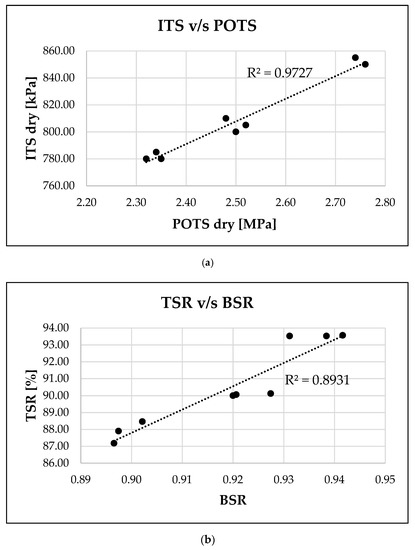
Figure 8.
Correlation between the ITS and BBS test: (a) ITS dry vs. Pull-Off Tensile Strength (POTS) dry and (b) TSR vs. BSR.
4.5. Statistical Analysis
The above testing results were statistically analyzed by a one-way ANOVA (significance level α = 0.05) using MINITAB to examine the significance of modifiers in the rutting, moisture-induced damage, and workability properties, as shown in Table 8. It is clearly evident that the modifier types had significant effects (p < 0.05) for all the parameters related to workability (viscosity, CDI, and TDI values of the Bahia and locking point methods). TDI had the most significant effect because it had the highest F value, followed by the viscosity and CDI values. Similarly, Table 8 indicates that the effects of the modifier types were statistically significant with respect to the rutting properties (%R and Jnr from the multiple stress recovery test; rut depth and dynamic stability values from the wheel tracking test) based on the probability value (p < 0.05). Jnr had the most significant effect because it had the highest F value, followed by the %R, dynamic stability, and rut depth values. Table 8 also evidently indicates that the effects of modifier types were statistically significant with respect to the POTS, ITS, BSR, and TSR values based on the probability value (p < 0.05). POTS had the most significant effect because it had the highest F value, followed by the BSR, ITS, and TSR values.

Table 8.
ANOVA analysis of the various performance parameters.
5. Conclusions
Based on the rutting, moisture-induced damage, and workability test results, the following conclusions were drawn:
- The mix design properties (VTM, VFA, and VMA) of CB, CRMB, and PMB mixtures were well within the requirements. A lower density was observed with the CRMB and PMB mixtures compared to the CB mixture.
- The workability and viscosity results indicate that the addition of modifiers reduces the pumping ability and workability of the asphalt binder and mixtures, respectively. Further, the CRMB exhibited a better rutting resistance and was less workable compared to the PMB mixture.
- The rut depth and dynamic stability results indicate that the addition of modifiers increases the rut resistance due to the fact that the CRMB and PMB mixtures exhibited higher VMA values, and also the addition of modifiers resulted in a stiffer mixture. However, CRMB exhibited a better rutting resistance compared to the PMB mixture.
- The MSCR results indicate that the addition of modifiers resulted in changing the vehicular loading grading to a higher traffic loading condition. Further, the addition of modifiers resulted in an increase in the stress sensitivity towards the varied axle loading pattern, but this was within the requirements.
- The ITS results indicate that the addition of modifiers increases the resistance of the moisture-induced damage of HMA mixtures, which is attributable to the higher binder content, which increases the film thickness, making the mixture rut-resistant. Further, the PMB mixtures had increased resistance to moisture-induced damage, while the effect of CRMB mixtures was negligible compared to that of CB mixtures. However, the TSR values of the CB, CRMB, and PMB mixtures fulfilled the minimum TSR requirements.
- The BBS results indicate that the addition of modifiers increases the bond strength of the asphalt binders. Further, the CRMB and PMB binders had a negligible effect on the bond strength properties.
- Additionally, the effects of modifier types were found to be statistically significant in relation to the workability, rutting, and moisture-induced damage properties.
Author Contributions
Conceptualization, methodology, original draft preparation, conducting experimental tests—J.H.; writing—review and editing, Y.S. All authors have read and agreed to the published version of the manuscript.
Funding
This research received no external funding.
Conflicts of Interest
The authors declare no conflict of interest.
References
- Walubita, L.F.; Faruk, A.N.; Lee, S.I.; Nguyen, D.; Hassan, R.; Scullion, T. Hma Shear Resistance, Permanent Deformation, and Rutting Tests for Texas Mixes: Final Year-2 Report; Technical Report for Texas A&M Transportation Institute: College Station, TX, USA, November 2014. [Google Scholar]
- Wang, G.; Roque, R.; Morian, D. Effects of surface rutting on near-surface pavement responses based on a two-dimensional axle-tire-pavement interaction finite-element model. J. Mater. Civ. Eng. 2012, 24, 1388–1395. [Google Scholar] [CrossRef]
- Zhang, W.; Shen, S.; Wu, S.; Mohammad, L.N. Prediction model for field rut depth of asphalt pavement based on hamburg wheel tracking test properties. J. Mater. Civ. Eng. 2017, 29, 04017098. [Google Scholar] [CrossRef]
- Kim, Y.-R.; Park, H.M.; Aragão, F.T.S.; Lutif, J.E.S. Effects of aggregate structure on hot-mix asphalt rutting performance in low traffic volume local pavements. Constr. Build. Mater. 2009, 23, 2177–2182. [Google Scholar] [CrossRef]
- Lv, Q.; Huang, W.; Sadek, H.; Xiao, F.; Yan, C. Investigation of the rutting performance of various modified asphalt mixtures using the hamburg wheel-tracking device test and multiple stress creep recovery test. Constr. Build. Mater. 2019, 206, 62–70. [Google Scholar] [CrossRef]
- Tian, Y.; Lee, J.; Nantung, T.; Haddock, J.E. Development of a mid-depth profile monitoring system for accelerated pavement testing. Constr. Build. Mater. 2017, 140, 1–9. [Google Scholar] [CrossRef]
- Morea, F.; Agnusdei, J.O.; Zerbino, R. The use of asphalt low shear viscosity to predict permanent deformation performance of asphalt concrete. Mater. Struct. 2011, 44, 1241–1248. [Google Scholar] [CrossRef]
- Shiva Kumar, G.; Shankar, A.R.; Ravi Teja, B. Laboratory evaluation of sma mixtures made with polymer-modified bitumen and stabilizing additives. J. Mater. Civ. Eng. 2019, 31, 04019026. [Google Scholar] [CrossRef]
- Shiva Kumar, G.; Suresha, S. Evaluation of properties of nonfoaming warm mix asphalt mixtures at lower working temperatures. J. Mater. Civ. Eng. 2017, 29, 04017229. [Google Scholar] [CrossRef]
- Shiva Kumar, G.; Suresha, S. State of the art review on mix design and mechanical properties of warm mix asphalt. Road Mater. Pavement Des. 2019, 20, 1501–1524. [Google Scholar] [CrossRef]
- Kumar, G.S.; Shankar, A.R. Evaluation of workability and mechanical properties of stone matrix asphalt mixtures made with and without stabilizing additives. Transp. Infrastruct. Geotechnol. 2020, 7, 191–204. [Google Scholar] [CrossRef]
- Lee, S.-J.; Amirkhanian, S.N.; Putman, B.J.; Kim, K.W. Laboratory study of the effects of compaction on the volumetric and rutting properties of crm asphalt mixtures. J. Mater. Civ. Eng. 2007, 19, 1079–1089. [Google Scholar] [CrossRef]
- Saboo, N.; Kumar, P. Analysis of different test methods for quantifying rutting susceptibility of asphalt binders. J. Mater. Civ. Eng. 2016, 28, 04016024. [Google Scholar] [CrossRef]
- D’Angelo, J.; Kluttz, R.; Dongre, R.N.; Stephens, K.; Zanzotto, L. Revision of the superpave high temperature binder specification: The multiple stress creep recovery test (with discussion). J. Assoc. Asph. Paving Technol. 2007, 76, 123–162. [Google Scholar]
- Singh, D.; Ashish, P.K.; Jagadeesh, A. Influence of particle and interaction effects of different sizes of crumb rubber on rheological performance parameters of binders. J. Mater. Civ. Eng. 2018, 30, 04018066. [Google Scholar] [CrossRef]
- D’Angelo, J.A. The relationship of the mscr test to rutting. Road Mater. Pavement Des. 2009, 10, 61–80. [Google Scholar] [CrossRef]
- Zhang, J.; Walubita, L.F.; Faruk, A.N.; Karki, P.; Simate, G.S. Use of the mscr test to characterize the asphalt binder properties relative to hma rutting performance–a laboratory study. Constr. Build. Mater. 2015, 94, 218–227. [Google Scholar] [CrossRef]
- Habal, A.; Singh, D. Influence of recycled asphalt pavement on interfacial energy and bond strength of asphalt binder for different types of aggregates. Transp. Res. Rec. 2018, 2672, 154–166. [Google Scholar] [CrossRef]
- Sun, Y.; Zhang, J.; Li, G.; Wang, Y.; Sun, J.; Jiang, C. Optimized neural network using beetle antennae search for predicting the unconfined compressive strength of jet grouting coalcretes. Int. J. Numer. Anal. Methods Geomech. 2019, 43, 801–813. [Google Scholar] [CrossRef]
- Kassem, E.; Masad, E.; Bulut, R.; Lytton, R. Measurements of moisture suction and diffusion coefficient in hot-mix asphalt and their relationships to moisture damage. Transp. Res. Rec. 2006, 1970, 45–54. [Google Scholar] [CrossRef]
- Bahia, H.U.; Friemel, T.P.; Peterson, P.A.; Russell, J.S.; Poehnelt, B. Optimization of constructibility and resistance to traffic: A new design approach for hma using the superpave compactor. J. Assoc. Asph. Paving Technol. 1998, 67, 189–232. [Google Scholar]
- Mohammad, L.N.; Al-Shamsi, K. A Look at the Bailey Method and Locking Point Concept in Superpave Mixture Design. In Transportation Research Circular EC124 Practical Approaches to Hot-Mix Asphalt Mix Design and Production Quality Control Testing; University of Texas: Austin, TX, USA, 2007; pp. 24–32. [Google Scholar]
- Hanz, A.J.; Faheem, A.; Mahmoud, E.; Bahia, H.U. Measuring effects of warm-mix additives: Use of newly developed asphalt binder lubricity test for the dynamic shear rheometer. Transp. Res. Rec. 2010, 2180, 85–92. [Google Scholar] [CrossRef]
- Vavrik, W.R.; Fries, R.J.; Carpenter, S.H. Effect of flat and elongated coarse aggregate on characteristics of gyratory compacted samples. Transp. Res. Rec. 1999, 1681, 28–36. [Google Scholar] [CrossRef]
- Leiva, F.; West, R.C. Analysis of hot-mix asphalt lab compactability using lab compaction parameters and mix characteristics. Transp. Res. Rec. 2008, 2057, 89–98. [Google Scholar] [CrossRef]
- Design, S.M. Superpave Series no. 2 (sp-2); Asphalt Institute: Lexington, KY, USA, 1996. [Google Scholar]
Publisher’s Note: MDPI stays neutral with regard to jurisdictional claims in published maps and institutional affiliations. |
© 2020 by the authors. Licensee MDPI, Basel, Switzerland. This article is an open access article distributed under the terms and conditions of the Creative Commons Attribution (CC BY) license (http://creativecommons.org/licenses/by/4.0/).